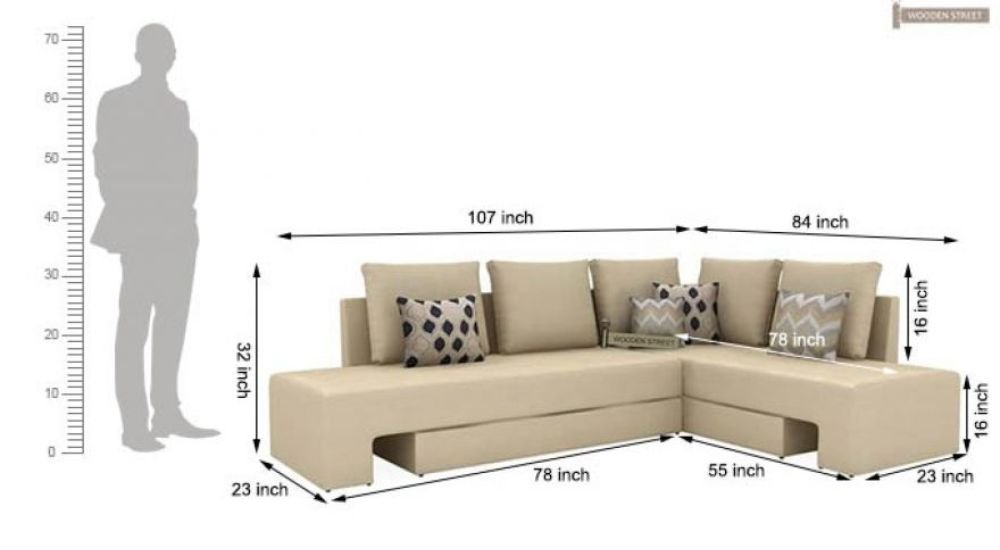
Sofa dimensions are a critical yet often overlooked aspect when furnishing your home. Picking the wrong size can lead to discomfort, spatial inefficiency, and a mismatched design aesthetic. This comprehensive guide delves into everything you need to know about sofa dimensions, ensuring you make the best choice for your space and lifestyle.
What Are Sofa Dimensions, and Why Do They Matter?
Sofa dimensions refer to the measurable aspects of a sofa, including its length, depth, height, and sometimes even the height of the seat and armrests. These measurements play a key role in determining whether a sofa will fit comfortably in your living space, complement your room’s proportions, and provide the desired level of comfort.
For instance, a sofa that is too long might overwhelm a compact living room, while a sofa that is too shallow might not provide adequate comfort for lounging. Understanding these dimensions ensures a perfect balance between functionality and aesthetics.
The Standard Dimensions of Sofas
Sofas come in a variety of standard sizes that cater to different room sizes and user needs.
- Three-Seater Sofas: Typically range from 84 to 90 inches in length, making them ideal for medium to large living rooms.
- Two-Seater Sofas: These are compact, measuring around 60 to 72 inches, and work well in smaller spaces or as complementary seating.
- Loveseats: Designed for two people, loveseats are even smaller, with lengths ranging from 48 to 60 inches.
- Sectional Sofas: These modular pieces vary greatly in size, often starting at 94 inches and extending to 156 inches or more, depending on the configuration.
Factors to Consider When Choosing Sofa Dimensions
Your room’s size and layout are the foundation for selecting the right sofa dimensions. Before shopping, measure your room’s length, width, and height. Factor in pathways, other furniture, and focal points such as windows or fireplaces. A sofa that fits snugly into your space while leaving enough room for movement will enhance both functionality and aesthetics.
For open-plan layouts, consider how the sofa will interact with adjacent areas. In tighter spaces, compact designs like loveseats or apartment-sized sofas can prevent overcrowding.
Purpose of the Sofa: Defining Its Functionality
What will you primarily use the sofa for? If it’s for casual lounging in a family room, opt for deeper seats and softer cushions. If it’s for a formal setting, a sleeker design with firmer support may be more appropriate. For multi-functional spaces, sleeper sofas can serve as both seating and a guest bed, making them a versatile choice.
User Preferences: Comfort and Accessibility
Comfort is subjective, so consider who will use the sofa. For taller individuals, a deeper seat depth (around 24–25 inches) may be more comfortable, while shorter users might prefer a depth of 20–22 inches. Similarly, the height of the backrest and armrests should align with your comfort needs. Families with children may prioritize durable, easy-to-clean materials over luxurious finishes.
Exploring the Dimensions of Different Sofa Types
Standard Sofas: A Timeless Choice
Standard sofas are the most common type and come in a range of sizes to fit different spaces. Their versatility makes them suitable for living rooms, family rooms, and even offices. With lengths ranging from 72 to 96 inches, they are perfect for seating three to four people.
Sectional Sofas: Flexible and Spacious
Sectional sofas are designed to maximize seating capacity and flexibility. They can be configured into L-shaped or U-shaped layouts and are ideal for large living rooms or open-plan spaces. Their dimensions can vary significantly, with some extending over 12 feet in length. Modular designs allow you to customize the size and shape to suit your room.
Loveseats: Small but Mighty
Loveseats are compact sofas designed to seat two people comfortably. With lengths ranging from 48 to 60 inches, they are perfect for small apartments, bedrooms, or as supplementary seating in larger rooms. Their petite size doesn’t compromise on comfort, making them a great choice for cozy spaces.
Sleeper Sofas: Dual-Purpose Convenience
Sleeper sofas offer the versatility of a sofa by day and a bed by night. These are available in various sizes, from twin to queen-sized beds. When extended, their lengths can range from 70 to 90 inches, making them a practical option for guest rooms or studio apartments.
How to Measure Sofa Dimensions Accurately
To measure a sofa correctly, you’ll need a measuring tape, a notepad, and a bit of patience. Begin by measuring the length from one armrest to the other. Next, measure the depth by checking the distance from the front edge of the seat to the backrest. Lastly, measure the height from the floor to the top of the backrest.
For sectional or modular sofas, measure each segment individually and account for the overall footprint when arranged.
Measuring Your Room for a Sofa
Measure the entry points, including doorways, staircases, and elevators, to ensure the sofa can be delivered without hassle. Additionally, leave at least 18 inches of walking space around the sofa to maintain a functional layout.
Customizing Sofa Dimensions for Unique Spaces
If standard sizes don’t meet your needs, customizing your sofa may be the answer. Custom-made sofas allow you to adjust dimensions, materials, and finishes to create a piece tailored to your space. While this option is often more expensive, it ensures a perfect fit and a unique design.
Conclusion
Choosing the right sofa dimensions is about more than just fitting a piece of furniture into a room. It’s about creating a comfortable, functional, and visually pleasing environment that enhances your daily life. By considering factors such as room size, functionality, and personal preferences, you can find a sofa that checks all the boxes.